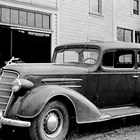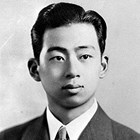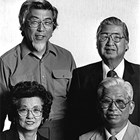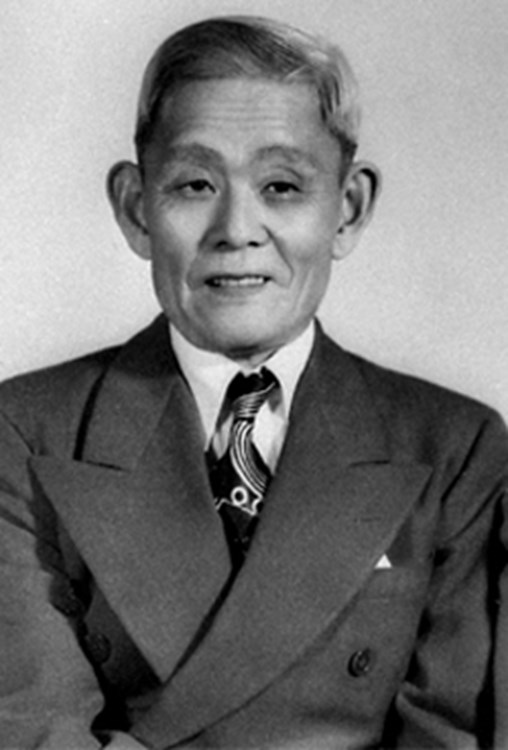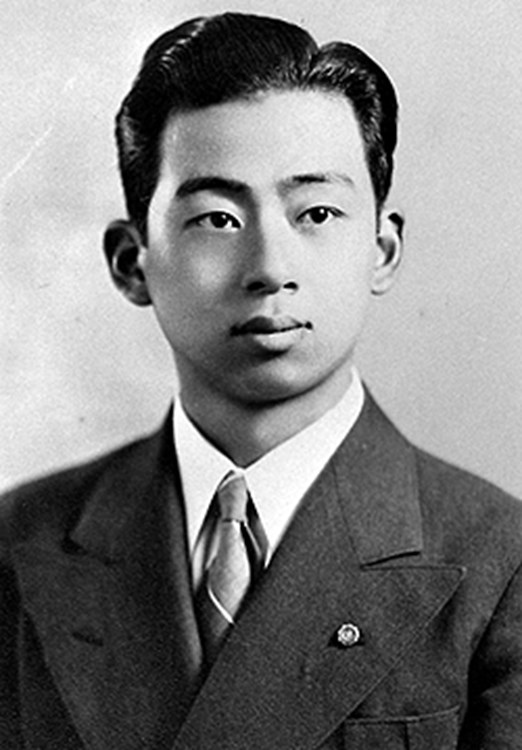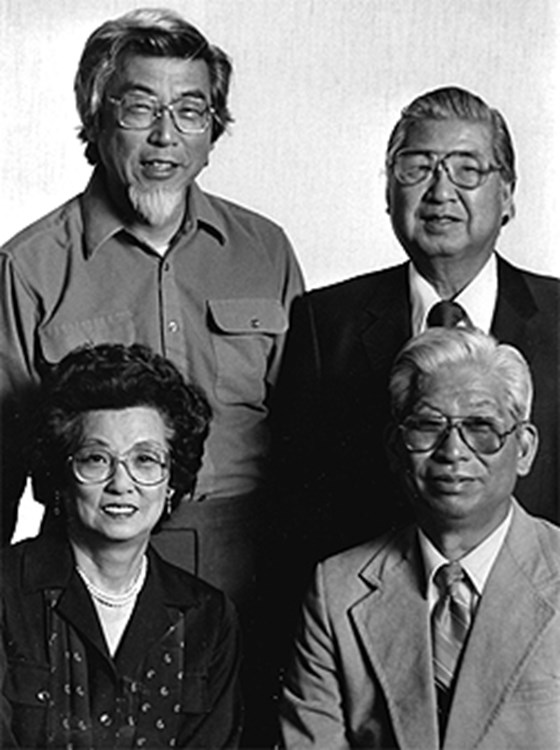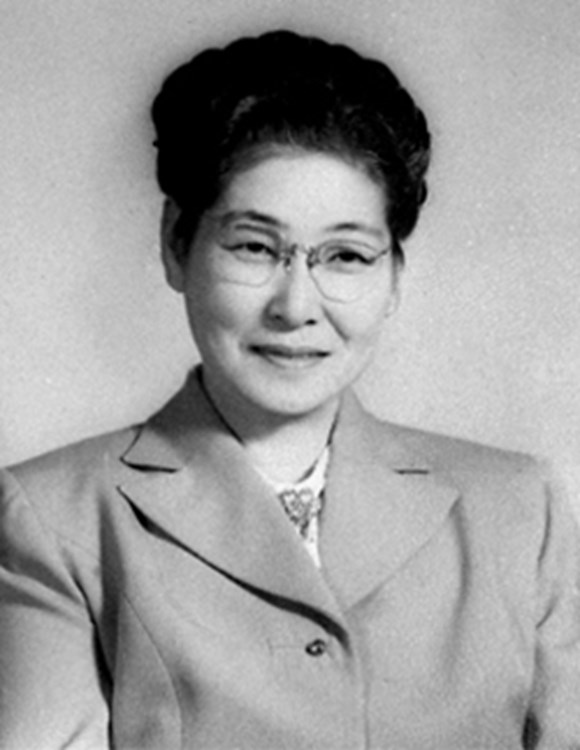Kimura, Yusuke "Harry"
1880-1957 | Businessman
The Kimura family’s roots in Anchorage reach to its beginnings as an Alaska Railroad construction camp in 1916. Yusuke Kimura became established in Anchorage, becoming the proprietor of several small businesses and, “to a small degree, prospered.”[1] He established H & K Laundry on 5th Avenue and C Street and the Chop Suey House. Later, he and his family opened Snow White Laundry and Cleaners and Nikko Gardens Café, the first Oriental restaurant in Anchorage. It was Harry Kimura’s lifelong regret that he was ineligible for U.S. citizenship, as all of his children were American-born citizens.[2] For four generations, the Kimura family enriched Anchorage through their talent and energy.[3]
Early Years
Yusuke "Harry" Kimura was born in Nagasaki, Japan on January 15, 1880, the son of Sahichi Kimura and Kita Ono.[4] Kimura left his home in Nagasaki when he was thirteen to seek adventure and traveled around the world working different jobs, and learning to be a cook. About 1901, he became an employee of the U.S. Navy aboard the U.S.S. Albany.[5]
At the age of twenty-eight, Kimura immigrated to the United States in 1908,[6] and for about the next seven years he followed the mining and logging camps on the west coast, working as a cook.[7] During this period, Kimura was hired as a construction camp cook by the Southern Pacific Railroad, and he worked in the southwestern states until a friend suggested that he move to Seattle, Washington.
In Seattle, Kimura started a restaurant and his business was successful enough for him to write home to arrange for a bride.[8] In 1913, he met Katsuyo Yamasaki in Seattle, Washington, and on May 23, 1913, they were married at the Buddhist Temple, in Seattle.[9] Katsuyo was born in Nagasaki, Japan on December 4, 1894 and immigrated to the United States, arriving in Seattle in 1913.[10] Their first two children were born in Seattle, Frank M. (born on April 29, 1914),[11] and George Yoshito (born on January 31, 1916).[12] However, the depressed economy in Seattle forced Kimura to explore better business opportunities associated with the construction of the Alaska Railroad.[13]
Arrival in Anchorage (1916)
In 1916, the Kimura family moved to Anchorage where they took over a small hand laundry from a relative and named it the H & K Hand Laundry, located adjacent to the northeast corner of 5th Avenue and C Street. They also started a small restaurant called the Chop Suey House next door on the same corner. Harry Kimura operated the Chop Suey House, and Katsuyo Kimura ran the laundry. They had three more children, Louise (born on February 24, 1918),[14] William ("Bill"), born in 1920, and Sam (born in 1928). Later, Sam Kimura provided this description of the family’s beginnings:
“I think we had a cousin here who was doing laundry. My father and mother took over the existing laundry. They started a tiny restaurant next door. Everything was done by hand. There was no running water. The miners and trappers brought in their clothes. I remember stories about the long underwear. When my mother washed them, the lice would come floating to the top of the water.”[15]
After the arrival of the Kimura family in Anchorage, business became slow. Even before the United States entered World War I in 1917, the wartime preparedness boom drew men from the Alaska Railroad and decimated its labor force, and construction of the Alaska Railroad stalled. The day when Kimura sold only one five-cent bowl of soup, he decided to return to Seattle to seek a better living. When Kimura could not support his growing family there, he was forced to send their four children—Frank, George, Louise, and William—to live with relatives in Japan.[16]
It was five years, in 1926, before the Kimura family was finally reunited in Anchorage. They went back into business with the H & K Hand Laundry and the Chop Suey House in their original location, and started a tailor shop. The family had increased, with the youngest son, Sam Isamu, born in 1928. As the family grew, each member had a job to do in the laundry and in the restaurant.[17]
World War II
The Japanese attack on Pearl Harbor, Hawaii, on December 7, 1941, and America’s entry into World War II changed the lives of the Kimura family. The attack led to a period of wartime hysteria about national security, especially on the West Coast.[18] On February 19, 1942, President Franklin D. Roosevelt issued Executive Order 9066,[19] to relocate west coast Japanese into internment camps, inland, outside of the Pacific military zone.[20] The order, in effect, gave the U.S. Army, through the secretary of war, the authority to circumvent the constitutional safeguards of American citizens of Japanese heritage in the name of national security and to establish military areas from which “any and all persons may be excluded” and to provide for such persons “transportation, food, shelter, and other accommodations as may be necessary . . . until other arrangements are made.” Although the Japanese and Japanese Americans were not specifically mentioned in the order, they were the only group affected. Historian Roger Daniels, the leading scholar on the evacuation, later wrote that “the legal atrocity . . . committed against the Japanese Americans was the logical outgrowth of over three centuries of American experience” where white citizens were taught that they lived in a country where nonwhites had no inviolable rights.[21] The military forced about 112,000 men[22], women, and children --practically the entire Japanese-American population in Washington, Oregon, and California— to leave their homes in the Pacific coast region. Persons of Japanese ancestry were ordered to assembly centers. They were sent to U.S. War Relocation Authority (WRA) internment camps outside the restricted military zones, in the interior, which were surrounded by barbed wire and guarded by military detachments. Most of the 112,000 persons removed were young adults not of voting age, school-age children, and infants,[23] and two-thirds of the total were native-born citizens of the United States. Included in this removal order were over two hundred of Alaska’s Japanese, who were evacuated from the territory. They belonged to four categories: the Issei, or immigrants who had lived for a long time in Alaska but were ineligible for naturalization to become American citizens; the Nisei, or persons of Japanese alien immigrant heritage born in Alaska and therefore American citizens; the children of Japanese-Caucasian and Japanese-Alaska Native unions who were both U.S. citizens by birth and Japanese nationals, such as members of ships’ crews passing through Alaska.[24] In total, fourteen Japanese residents of Anchorage and the surrounding area were sent to internment camps, including the Kimuras.[25]
On December 8, 1941, the Federal Bureau of Investigation (FBI) arrived at the Kimura home in the middle of the night, searched it, and confiscated many of their belongings. Harry Kimura was locked in a barracks at Fort Richardson, Alaska, where ironically, his son, George, was in basic training. According to the family, “At one point, George was doing MP duty outside of the detention center while his father was inside.”[27]
The evacuation of Alaska’s Japanese took place on April 17, 1942.[28] Many of Alaska’s Japanese expressed their concerns about the spirit of the times in the face of wartime hysteria. When the Kimuras were on their way to internment, in the Anchorage Daily Times, April 22, 1942, they thanked the “people of Anchorage for their long and faithful patronage and for their kindness and sympathy in these trying times.”[29]
Kimura was interned as an enemy alien, but the family continued operating the family businesses until the Executive Order 9066 to intern American-born Japanese. In August 1943, Harry was released from the Santa Fe Internment Camp, and permitted to join his family in Idaho.[30] After about a year, William “Bill,” who was attending art school in Los Angeles, joined his family at Camp Harmony, the assembly center in Puyallup, Washington.[31] When sent there, Frank and his wife were expecting twins, but living conditions were poor, and the twins did not survive. On August 31, 1942, the Kimura family was interned at Camp Minidoka, the U.S. War Relocation Authority camp northeast of Twin Falls, Idaho during the war period. Minidoka was a “godforsaken” site “where nobody had lived before.”[32] They obtained a permit to work outside of the camp under supervision and leased a small farm until their release in March 1945.[33]
Aftermath
After the war, most of the Kimura family returned to Anchorage. Their businesses suffered from lack of supervision for four years. Kimura raised enough money to pay the back taxes on his businesses and get a new start. The laundry expanded into a full-fledged operation called the Snow White Laundry and Cleaners and like all Kimura enterprises, was known for its service. It was the largest such business in Anchorage and was highly successful. After Frank’s death at the age of thirty-eight in 1951, George continued to expand the business until it was sold in 1966. The Kimuras also opened the Golden Pheasant Café on D Street between 4th and 5th Avenues. In 1966, George Kimura opened the Nikko Garden restaurant on Spenard Road near Lake Spenard. It was considered the city’s finest Oriental restaurant until it burned down in 1979. The Golden Pheasant closed, and William Kimura went to work at Snow White Laundry and Cleaners, as did daughter Louise Kimura.
Sam Kimura opened a photography studio but decided to go to photography school in New York. He worked as a commercial photographer in New York for seventeen years. Educated as a professional photographer and art teacher, he returned to Anchorage in 1972 with his wife, Joan, a commercial and fine artist. He begin his teaching career at the University of Alaska Anchorage, where he taught photography for twenty-three years until his retirement and their move Outside in 1994. The exhibition gallery at the University of Alaska Anchorage Arts Building is named after Sam Kimura.[34]
William "Bill" Kimura was a noted painter and sculptor who also taught at the Anchorage Community College and Alaska Methodist University (AMU). Before joining the APU faculty, he went to schools with the Arts in Schools program to teach junior high students and also taught classes at Elmendorf Air Force Base and Fort Richardson. In 1966, he was named as artist-in-residence and began teaching at AMU. In 1976, he became printmaker-in-residence at the Visual Arts Center.[35] The art works of William "Bill," Sam, and Joan Kimura are in numerous private and public collections in Alaska and elsewhere, and all three have received recognition in numerous ways for their contributions to the arts in Anchorage.
Yusuke "Harry" Kimura died on November 26, 1957, in Tokyo, Japan, while visiting there with his wife.[36] Katsuyo Kimura became an unpaid goodwill ambassador to Asian visitors. In 1971, she was honored with the Zuiho Sho, the sixth order of Sacred Treasure, a medal awarded by the Emperor of Japan, for her outstanding service fostering good relations between Japan and the United States. She died on December 20, 1975 while visiting Hawaii.[37] Yusuke "Harry" and Katsuyo Kimura, along with sons Frank, George, William, and Sam, are buried at the Anchorage Memorial Park Cemetery.
Endnotes
[1] Quoted from “A Message from the Kimura Family,” Anchorage Daily Times, December 8, 1941. Claus M.-Naske, “The Relocation of Alaska’s Japanese Residents,” Pacific Northwest Quarterly 74, no. 3 (July 1983), 124, http://www.jstor.org/stable/40490551 (accessed December 4, 2016). The letter is reproduced, in full, in Preston Jones, City for Empire: An Anchorage History, 1914-1941 (Fairbanks: University of Alaska Press, 2010), 158.
[2] Claus M.-Naske, stated that the Issei, or first-generation immigrants of Japanese ancestry, “were ineligible for naturalization because of the Naturalization Act of 1870 (the 1924 Immigration Act used that ineligibility as a way of denying a quota for Japan).” Claus M.-Naske, “The Relocation of Alaska’s Japanese Residents,” Pacific Northwest Quarterly 74, no. 3 (July 1983), 124, http://www.jstor.org/stable/40490551 (accessed December 4, 2016).
[3] See, T. Massari McPherson, “Pioneer Family Enriches Alaska,” Anchorage Times, May 19, 1991, H1 and H5; Julia Sopalski, “William Kimura Never Needed a Studio,” Anchorage Times, May 19, 1991, H1 and H5; and Nancy Jordan, “Kimuras have Influenced many Young Artists,” Anchorage Times, May 19, 1991, H5.
[4] Yusuke Kimura, U.S., Social Security Applications and Claims Index, 1936-2007 [database on-line], http://ancestry.com (accessed August 6, 2016).
[5] See Document 15, “A Message from the Kimura Family,” Anchorage Daily Times, December 8, 1941; reprinted in Preston Jones, City for Empire: An Anchorage History, 1914-1941 (Fairbanks: University of Alaska Press, 2010), 158.
[6] Yusuhi Kimura [Yusuke Kimura], U.S. 1920 Census, Anchorage, Third Judicial District, Alaska, ED 11, page 2B, National Archives Microfilm Publication T625, Fourteenth Census of the United States, 1920, Roll 2031, 1920 United States Federal Census [database on-line], http://ancestry.com (accessed December 4, 2016).
[7] T. Massari McPherson, “Pioneer Family Enriches Alaska,” Anchorage Times, May 19, 1991, H1 and H5; Elizabeth Tower, Anchorage: From Its Humble Beginnings as a Railroad Construction Camp (Fairbanks, AK: Epicenter Press, 1999), 91-92; and John P. Bagoy, Legends & Legacies, Anchorage, 1910-1935 (Anchorage: Publications Consultants, 2001), 132-134.
[8] Sam Kimura later recounted: “It was like a mail-order bride, but when the lady walks off the boat, it wasn’t the woman he was expecting—it was her sister. The other woman had already gotten married, so [her] parents sent the sister instead [i.e., Katsuyo Yamasaki].” T. Massari McPherson, “Pioneer Family Enriches Alaska,” Anchorage Times, May 19, 1991, H1.
[9] Marriage certificate, Yusuke Kimura and Katsuyo Yamasaki, Washington, Marriage Records, 1865-2004 [database on-line], http://ancestry.com (accessed August 6, 2016).
[10] “Pioneer Settler, Mrs. Kimura Dies,” Anchorage Daily Times, December 23, 1975, 7.
[11] Masako [Frank] Kimura, Washington Births, 1907-1919 [database on-line], http://ancestry.com (accessed December 4, 2016).
[12] Obituary, George Y. Kimura, Anchorage Daily News, October 2, 1998, D-5.
[13] Elizabeth Tower, Anchorage: From Its Humble Beginnings as a Railroad Construction Camp, 92.
[14] Obituary, Louise Kimura Wood, Anchorage Daily News, March 23, 2001, B-7.
[15] T. Massari McPherson, “Pioneer Family Enriches Alaska,” Anchorage Times, May 19, 1991, H1.
[16] T. Massari McPherson, “Pioneer Family Enriches Alaska,” Anchorage Times, May 19, 1991, H1; and William H. Wilson, The Alaska Railroad in the Age of Steam, 1914-1945 (Boulder, CO: Pruett Publishing Company, 1977), 75.
[17] Elizabeth Tower, Anchorage: From Its Humble Beginnings as a Railroad Construction Camp, 92.
[18] Claus-M. Naske stated: “During the early months of 1942, the Japanese inflicted stinging defeats on the Allies. During those long weeks of military setbacks, President Franklin D. Roosevelt ratified an action [E.O. 9066] that was widely accepted at the time but later viewed as one of the sorriest episodes in American history.” Claus M.-Naske, “The Relocation of Alaska’s Japanese Residents,” Pacific Northwest Quarterly 74, no. 3 (July 1983), 124, http://www.jstor.org/stable/40490551 (accessed December 4, 2016).
[19] For further information, see the primary documents and published sources listed in the section, Japanese Relocation during World War II, National Archives and Records Administration (NARA), https://www.archives.gov/education/lessons/japanese-relocation (accessed December 6, 2016). This is a unit in the Teaching with Documents series, which contains on-line documents and photographs on a large number of historical topics and are available for teachers, students, and other researchers on the NARA website.
[20] For Washington and Oregon, the eastern boundary of this imaginary line ran along the rim of the Cascade Mountains, and continued down the spine of California from north to south.
[21] Quoted in, Claus M.-Naske, “The Relocation of Alaska’s Japanese Residents,” Pacific Northwest Quarterly 74, no. 3 (July 1983), 124, http://www.jstor.org/stable/40490551 (accessed December 4, 2016). See also, Japanese Relocation during World War II, National Archives and Records Administration (NARA), https://www.archives.gov/education/lessons/japanese-relocation (accessed December 6, 2016).
[22] The higher figure of 117,000 Japanese internees is listed in Japanese Relocation during World War II, National Archives and Records Administration (NARA), https://www.archives.gov/education/lessons/japanese-relocation (accessed December 6, 2016).
[23] Michi Nishimura Weglyn, Years of Infamy: The Untold Story of America’s Concentration Camps (New York: Morrow, 1976), Children of the Camps Project, The Children of the Camps: The Documentary, Public Broadcasting Service (PBS), http://www.pbs.org/childofcamp (accessed December 5, 2016).
[24] Claus M.-Naske, “The Relocation of Alaska’s Japanese Residents,” Pacific Northwest Quarterly 74, no. 3 (July 1983), 124, http://www.jstor.org/stable/40490551 (accessed December 4, 2016).
[25] Preston Jones, City for Empire: An Anchorage History, 1914-1941, 135.
[26] Claus-M. Naske, “The Relocation of Alaska’s Japanese Residents,” Pacific Northwest Quarterly 74, no. 3 (July 1983), 124, in footnote no. 1, directed readers to Personal Justice Denied: Report of the Commission on Wartime Relocation and Internment of Civilians (Washington, DC: Government Printing Office, 1982), 317-359. See also, Dean Kohlhoff, When the Wind Was a River: Aleut Evacuation in World War II (Seattle: University of Washington Press in association with the Aleutian/Pribilof Islands Association, 1995), and The Aleut Story http://aleutstory.tv (accessed December 6, 2016).
[27] T. Massari McPherson, "Pioneer Family Enriches Alaska,” Anchorage Times, May 19, 1991, H5.
[28] See, Claus M-Naske, “The Relocation of Alaska’s Japanese Residents,” Pacific Northwest Quarterly 74, no. 3 (July 1983), 127-128, http://www.jstor.org/stable/40490551 (accessed December 4, 2016).
[29] Preston Jones, City for Empire: An Anchorage History, 1914-1941, 136.
[30] Entry for Harry Kaduzo Kimura, National Archives Microfilm Publication M1865, Final Accountability Rosters of Evacuees at Relocation Centers, 1944-1946, Roll 8 (Minidoka, October 1945), U.S., Final Accountability Rosters of Evacuees at Relocation Centers, 1942-1946 [database on-line],http://ancestry.com (accessed December 6, 2016); T. Massari McPherson, “Pioneer Family Enriches Alaska,” Anchorage Times, May 19, 1991, H5; and Elizabeth Tower, Anchorage: From Its Humble Beginnings as a Railroad Construction Camp, 92.
[31] Elizabeth Tower, Anchorage: From Its Humble Beginnings as a Railroad Construction Camp, 92.
[32] Claus-M. Naske, “The Relocation of Alaska’s Japanese Residents,” Pacific Northwest Quarterly 74, no. 3 (July 1983), 127-128, http://www.jstor.org/stable/40490551 (accessed December 4, 2016).
[33] Elizabeth Tower, Anchorage: From Its Humble Beginnings as a Railroad Construction Camp, 92; and entry for Harry Kaduzo Kimura, National Archives Microfilm Publication M1865, Final Accountability Rosters of Evacuees at Relocation Centers, 1944-1946, Roll 8 (Minidoka, October 1945), U.S., Final Accountability Rosters of Evacuees at Relocation Centers, 1942-1946 [database on-line],http://ancestry.com (accessed December 6, 2016);
[34] John P. Bagoy, Legends & Legacies, Anchorage, 1910-1935, 133; Nancy Jordan, “Kimuras have Influenced many Young Artists,” Anchorage Times, May 19, 1991, H5; and “Photographer Sam Kimura Dies of Cancer,” Anchorage Daily News, June 25, 1996, B-1.
[35] Julia Sopalski, “William Kimura Never Needed a Studio,” Anchorage Times, May 19, 1991, H1 and H5.
[36] “Harry Kimura Rites Slated,” Anchorage Daily Times, May 23, 1958, 9.
[37] “Pioneer Settler, Mrs. Kimura Dies,” Anchorage Daily Times, December 23, 1975, 7.
Sources
This biographical sketch of Yusuke "Harry" Kimura is based on an essay which originally appeared in John Bagoy’s Legends & Legacies, Anchorage, 1910-1935 (Anchorage, AK: Publications Consultants, 2001), 132-134. See also the Harry Kimura file, Bagoy Family Pioneer Files (2004.11), Box 3, Atwood Resource Center, Anchorage, AK. Photographs courtesy of the Kimura family. Edited by Mina Jacobs, 2012. Note: edited, revised, and substantially expanded by Bruce Parham, December 6, 2016.
Preferred citation: Bruce Parham, “Kimura, Yusuke ‘Harry’,” Cook Inlet Historical Society, Legends & Legacies, Anchorage, 1910-1940, http://www.alaskahistory.org.
Major support for Legends & Legacies, Anchorage, 1910-1940, provided by: Anchorage Museum at Rasmuson Center, Atwood Foundation, Cook Inlet Historical Society, and the Rasmuson Foundation. This educational resource is provided by the Cook Inlet Historical Society, a 501 (c) (3) tax-exempt association. Contact us at the Cook Inlet Historical Society, by mail at Cook Inlet Historical Society, Anchorage Museum at Rasmuson Center, 625 C Street, Anchorage, AK 99501 or through the Cook Inlet Historical Society website, www.cookinlethistory.org.

